
Boston Chinatown Gate
Fun Facts about the Chinatown Gate
Boston's Chinatown is the third largest in the United States, and just as most are, there is a decorative gate at its entrance.
The Chinatown Gate was offered by the Taiwanese government to the City. The gate is engraved with two writings in Chinese: Tian Xia Wei Gong, a saying attributed to Sun Yat-sen that translates as "everything under the sky is for the people", and Li Yi Lian Chi, the four societal bonds of propriety, justice, integrity and honor.

Fun Facts about Boston Chinatown Gate
In 1974, China gave the Gate to the City of Boston as the gift for the United States Centennial Celebration.
It took seven years to figure out how to pay for the installation. In 1975, the City of Boston created the Edward Ingersoll Browne Fund to direct spending on various city art projects.
Ground breaking was on June 7, 1981.
When the gate was placed, the entrance onto Beach Street was closed off from car traffic. This was to reduce the congestion from the Expressway into Chinatown. The street was re-open during the construction of the Big Dig, which caused issues with trucks knocking down the lions.
There is a lion, otherwise known as Foo Dogs, on both sides of the Arch - each weighing a ton.
The Chinatown Gate Arch is 30-feet high
The words on top of the gate mean, "A World Shared By All" - It's the same phrase that's on the Chicago Chinatown Gate and the Chinatown Gate in San Francisco. In Chicago, the translation is "The World Belongs to the Commonwealth." This was a common saying in the early 1900s.
Rededicated October 1990
Taipei, Capital of Taiwan, is Boston Sister city since 1996.
The Chinatown Gate installation was officially funded by the Edward Ingersoll Browne Fund.
Foo Dogs Controversy
At one time there were four Foo Dogs in front of the Chinatown gate.
During the construction of the Big Dig, sometime between 1991 and 2007, the Foo statues, were replaced with replicas.
Two of the originals were placed in a private home in Lexington. The home was owned by Paul Pedini, a former vice president of Modern Continental. The other two were placed in front of the Kowloon restaurant in Saugus.
Paul Pedini claimed that the original Foo dogs were not needed anymore and initial plans indicated that they were going to be destroyed because they were damaged. He had two of them placed in the rooftop garden of a 2.2 million dollar home he was building in Lexington.
Once public, via a Boston Herald story, the City of Boston has asked for all the Foo Dogs to be returned.
Paul Pedini returned the two statues. Kowloon has declined to return there's saying that it was a gift by the Chinatown elders.
The statues in front of the gate are still the replicas. The city hasn't decided what to do with the originals that they have. There has been some suggestion to place them in the Boston's Mount Hope Cemetery.
The replicas cost the city $4,800 each. The original ones were part of the entire gate package estimated to cost between $400,000 to $500,000.
Getting to Chinatown Gate
Chinatown Gate is located at the intersection of Beach Street and Hudson Street. The best way to get there is to take the Red Line to South Station and walk to Beach Street.
PermalinkRoyal Coat of Arms
Royal Coat of Arms is Still in Boston
In the Massachusetts Old State House are various exhibits where visitors can learn a lot about the City of Boston.
Royal Coat of Arms in the Council Chamber
In the Council Chamber Room, is where the Royal Governor of Massachusetts met with members of his Council. It was where key decisions were made before the American Revolution.
One artifact that people may miss is the Royal Coat of Arms above the door as you enter the room. This is a copy of the lion and unicorn heraldic crest - as it would appear in the chamber room. If you want to see an older version, walk down the stairs to the Keayne Hall. If you want to see the original one - head to New Brunswick Canada.
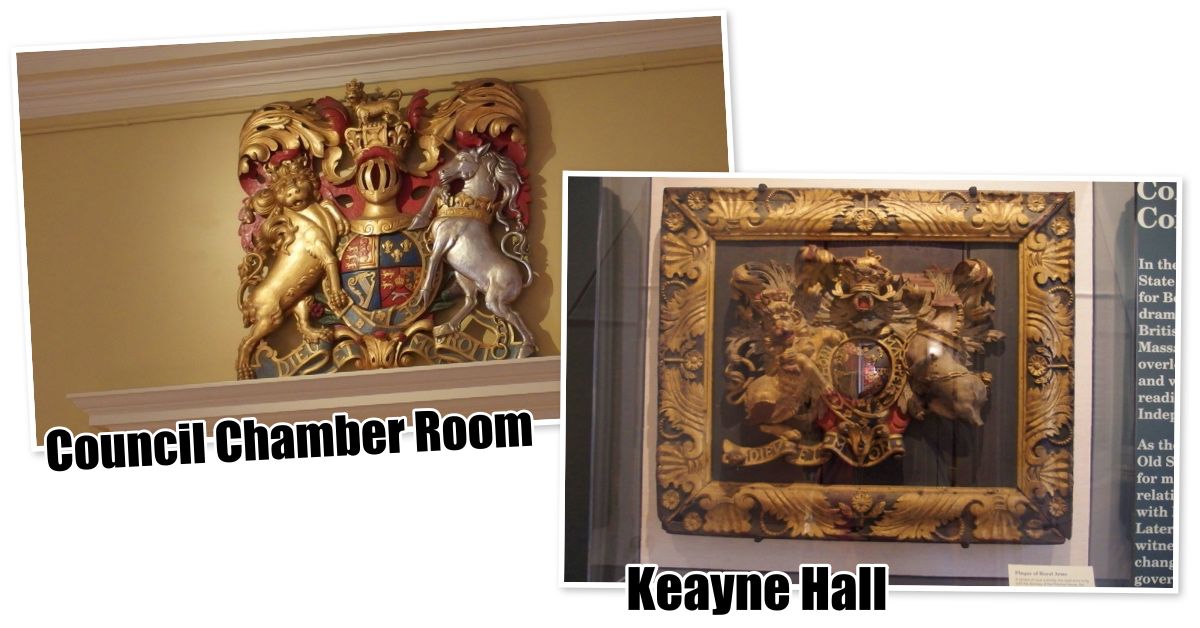
Four Fun Facts about the Royal Coat of Arms
- One of the original Coat of Arms was taken from Boston in 1775 and now appears over the doorway of the Trinity Episcopal Church, St. John New Brunswick. It was removed by the Revolutionaries to protect it from being damaged. It was brought to Halifax by Edward Winslow. Several requests have been made to return the Coat of Arms back to Boston but have been denied by the church.
- On the USS Constitution are some guns with the British Royal Coat of Arms.
- The Lion and Unicorn on the roof of the Old Massachusetts Statehouse are the same used in the Coat of Arms, a simple reminder of the past. The original Lion and Unicorn were burned in 1776. The ones currently on display were placed in 1882.
- The Royal Coat of Arms was once placed on the building at 17 Market Place. (Next to Faneuil Hall)
Sign next to the Coat of Arms in the Keayne Hall
A symbol of royal authority, this royal arms hung over the doorway of the Province House, the Governor's residence.
Boston, 18th century
Carved and painted wood
The Colby Trophy Room
Learn about the famous Colby Room at the Museum of Science
The Colby Trophy Room at the Boston Museum of Science is a unique room where you can view many prize animal mounts. The room is a replica of Colonel Franc is Colby Trophy Room in Hamilton, Massachusetts.
The room gives visitors a chance to see what the hunting life was like in the late 19th century
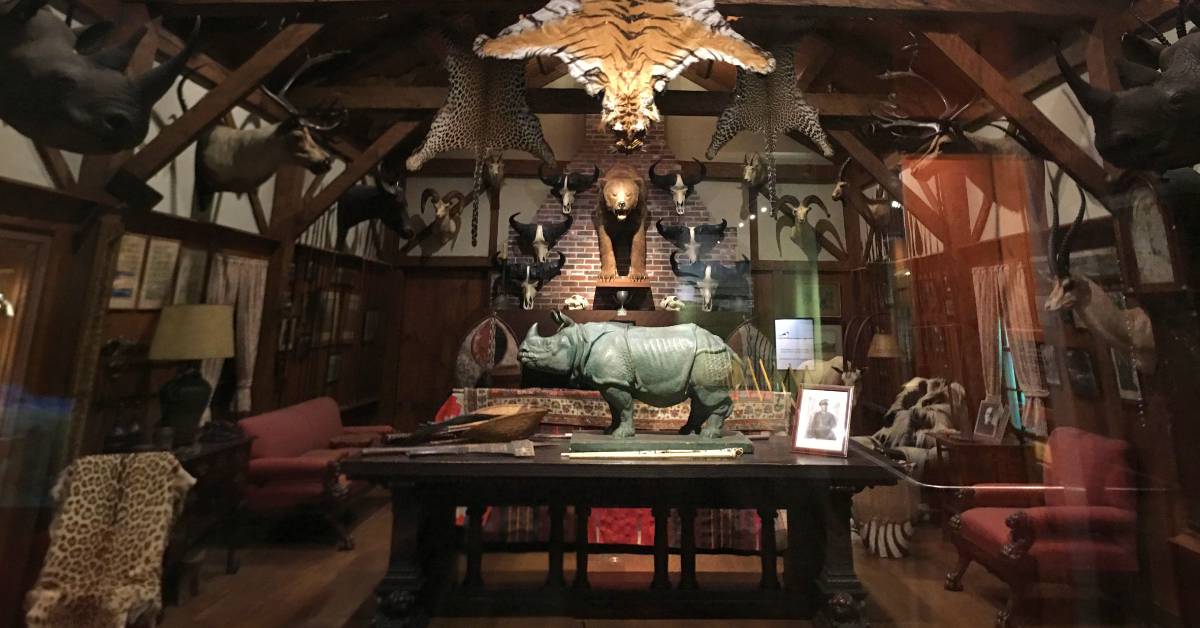
Ten Interesting Things about the Colby Trophy Room
- Colonel Francis T. Colby was a soldier, diplomat, and a big-game hunter.
- He died on July 30, 1953, and gave the museum $700,000 to build a replica of his trophy room. (At the time it was known as the Boston Society of Natural History.)
- If the Boston Museum of Science had not accepted the donation it would have gone to the Boone and Crockett Club of New York.
- The original room was smaller than the one at the museum - it was 20 by 40 feet. Clearly, the room in the museum is much bigger - in fact, it's about twice the size of the original room.
- He lived in Hamilton, Massachusetts and a house in Nairobi where he frequently visited.
- He shared various stories of the animals displayed in the room when people came to visit him. He never wrote them down - they might have made a great book. Many big-name visitors, with similar taste, would visit his house to see his well-decorated trophy room. Ernest Hemingway, Holt Collier, and other big-name game hunters visited the original trophy room.
- In the middle of the room, is a six-feet-long plaster cast model of an Indian rhino by notable Katherine W. Lane.
- In the original Museum designs, the room was to be placed on the third floor.
- Some of the Spears along with the side of the room still has poison on the tip.
- The museum recognized the large contribution that Colonel Francis Colby and name an annual award after him. The Francis Colby Award has bestowed annually on members of the Museum of Science family who have made extraordinary contributions of time, treasure, and talent to the Museum
Winthrop-Carter Building
Unique looking building near Downtown Crossing
At 7 Water Street is the Winthrop-Carter building Boston's first steel skyscraper. The Boston Landmark Commission calls it a "fine example of Second Renaissance Revival style."
The Winthrop-Carter Building is a 9-story steel frame building with steel external alls and brick terra cotta covering.
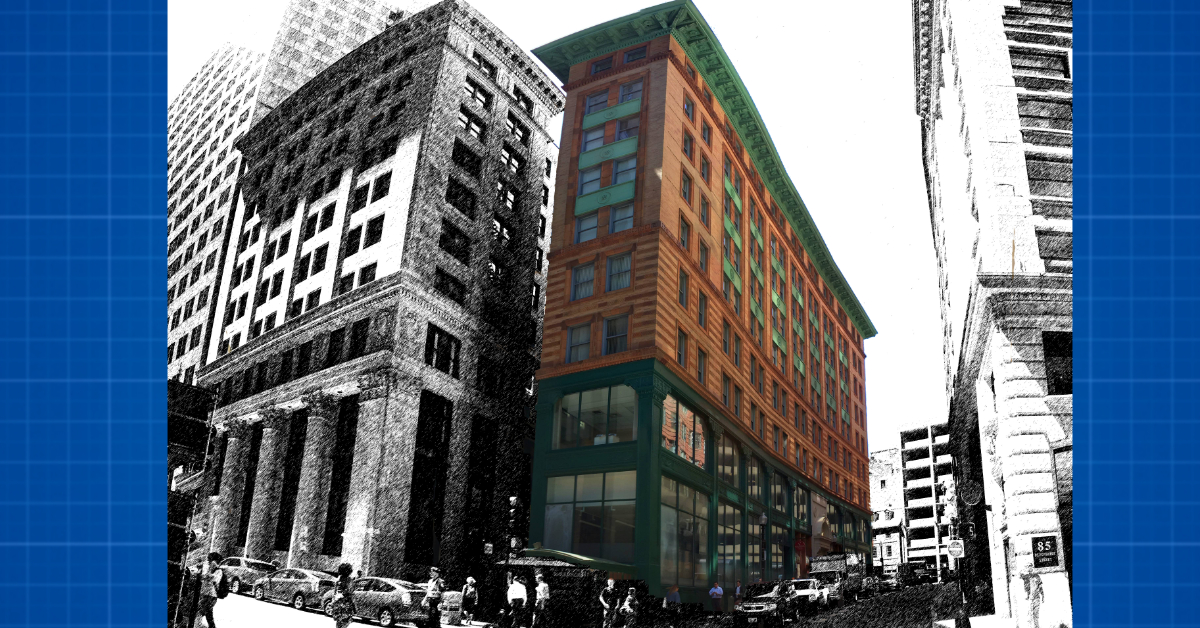
Nine Interesting things about the Winthrop-Carter Building
- This was near the location of the John Winthrop home. John Winthrop was Boston's first Colonial Governor.
- Current structure was created in 1893 at the request of the landowner - Timothy Harrington Carter. Clarence Blackall was the architect.
- When the original designs were presented to the city for permits they didn't propose a steel frame, instead they proposed a seven-story brick building. However, the City complicated things by reducing the property size by widen Washington Street and straighten Water Street. Clarence Blackall had to go "back to the drawing board" to come up with a better solution.
- When completed the building was assessed for $672,000. Today the building is assessed for $4,038,500
- The Building was called Carter Building until 1899 when it was renamed Winthrop-Carter Building.
- This wasn't the site of the Winthrop house, instead, this was the site of the Great Spring, which would have been next door to the Winthrop house.
- The Great Spring was one of the main sources of fresh water for Boston. The Spring has not been visible since 1702.
- The Devonshire Street Subway entrance is on the Winthrop-Carter property. It was put in 1903 - ten years after the building was completed.
- Building was listed on the National Register of Historic Places in December 1973, it took the City of Boston 43 years to designate the building as a Boston Landmark. (There are no signs around the building indicating that it's a Boston Landmark or on the National Register of Historic Places.)
Some Observations
When looking at the building, look at the Terra Cotta detail on the third and fourth floors. Also look at the stained glass on the Water Street side.
One thing I notice when walking down Spring Lane - it felt like a movie studio backlot. Just the small space and the window fire exits on the building.
Sign On the Building
Built in 1893, this was the first steel frame "skyscraper" constructed in Boston. It was the work of innovated local architect Clarence Blackall, who modeled this building on the early still commercial structures of Chicago. The office building received unprecedented attention in Boston, praised for its technological achievement and also for its graceful curved design and facade of colored brick and terra cotta. Originally built for businessman C. H. Cater, the structure was renamed in 1899 to recognize the location on the site of the home of the city's first colonial governor, John Winthrop.
Location of the Building
The Winthrop-Carter building is located near downtown crossing. It's located at the corner of Water Street and Washington Street - directly across the street from the Old Corner Bookstore.
PermalinkWorld War II Memorial in Boston
Some interesting information about Boston World War II memorial
Many people may not know that Boston has a rather large memorial for Bostonians that fought and died in World War II. The memorial is located in the Fenway area and called the George Robert White Veterans Memorial Park.
Did you Know: Massachusetts has 8 Memorials/Monuments to those that died in World War II and 20 Memorials/Monuments for those that died in World War I. (Source: MassVacations.com)
The Boston memorial is a large eclipse formed by granite structures, and include a winged figure in the center. Around the monument are seats which can accommodate an audience size of 500 people.
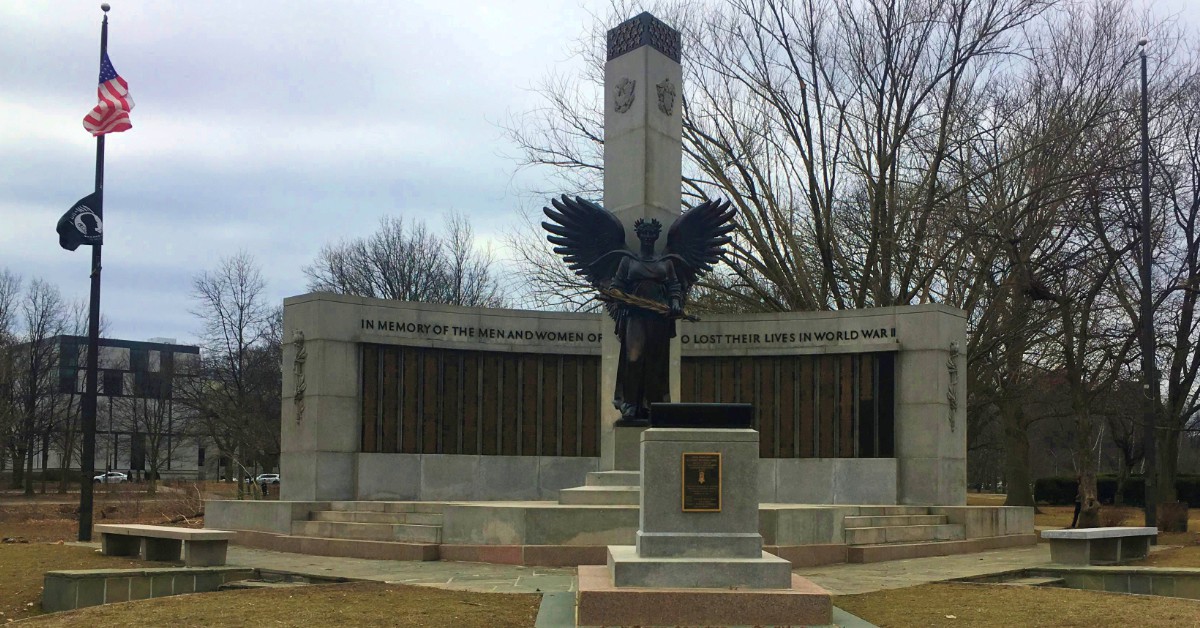
Thirteen Things interesting things I learned about the World War II Memorial
- Dedicated on October 30, 1949 (1,520 days after the official end of World War II)
- The memorial was Sculptor by John Francis Paramino and Tito Cascieri was the primary Architect
- The memorial was funded by a grant from the George Robert White Fund. (George Robert White was Boston's primary philanthropists.)
- In the center of the memorial is a "Winged Victory" statue that is 12-feet high. The statue was done by T.F. McGann & Sons Co. FDY of Somerville, Mass. You can see the artist inscription/signature on the bottom left of the statue.
- Behind the "Winged Victory" statue is a granite diamond-shape shaft of 22-feet and contain 48 stars. (Hawaii and Alaska didn't become a state yet)
- The names of 3,000 war dead are mounted in bronze behind the diamond-shape shaft.
- In The Memorial is named for U.S. Sergeant Charles A. MacGillivary - He was honored with a bronze plaque on the lectern which was added during a special dedication ceremony.
- Sergeant Charles Andrew MacGillivary was the only Medal of Honor, the only World War II vet from Boston to return alive with one. He died in 2000.
- The Korea and Vietnam Memorials were added in 1989 which were paid from a grant from the George Robert White Fund ($650,000)
- Above the names of the those that died it reads, "In memory of the men and women of Boston who lost their lives in World War II"
- Around the lectern stage is the phrase, "1949 From the Income of the George Robert White Fund"
- James W Sugden and Stanton H. Kelly are the only names added to the memorial since it was created in 1949.
- In 1946, James Michael Curley suggest that planting 2,400 trees in the Fenway would be a good tribute to the fallen. He suggested a shrine in the middle for religious services.
U.S. Sergeant Charles A. MacGillivary
Apparently there is a slight misprint on the bronze plaque on the lectern. I notice that U.S. Sergeant Charles A. MacGillivary is misspelled.
Check out the difference between his gravestone and the plaque on the memorial:
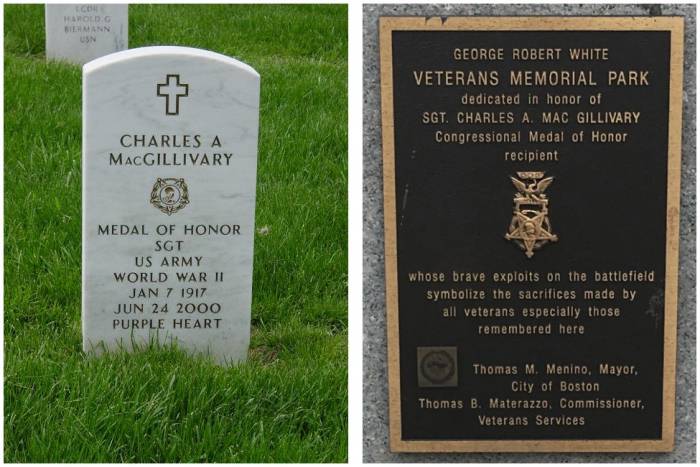
What do you think? Is MacGillivary spelled correctly?
Finding the World War II Memorial
To find George Robert White Veterans Memorial Park, you can enter the Back Bay Fens from the south at the intersection of the Fenway and Forsyth Way just east of the Boston Museum of Fine Arts. Cross over the Agassiz Bridge and bear right when the path forks. A path leads to it on the right. (You'll see the memorial when you cross Fenway Parkway.)
PermalinkQuaker Lane
Quaker Lane was one a cemetery in Boston
Quaker Lane is one of the few streets in Boston that is U-shape. For a 100 years, it was center of the Quaker Cemetary

Eight Things I learned About Quaker Lane
- Quaker Lane is called it because at one time it was the location of the Quaker Meeting House and Cemetery in downtown Boston.
- The Quakers built a meeting house on Quaker Lane in 1708. The Church was severely damaged by the Great Boston fire in 1760. (The Great Boston fire of 1760 destroyed 349 building in downtown Boston)
- The Quaker rebuilt the Meeting House and continued to worship there until 1808 when membership had declined and they decided to sell the property.
- In 1826, the remaining members thought it was best to move the Quaker cemetery to Lynn where the Quaker society was thriving.
- 109 bodies were moved to Lynn. Two bodies, who were sisters, were kept in Boston and reburied at the cemetery at King Chapel. (Mr. Joseph Hussey)
- It wasn't until the 1930s that it became Quaker Lane - it has always been known as Congress Square. Paul Townsend put in a request to rename Congress Square to Quaker Lane. It officially became Quaker Lane on February 19, 1930.
- Today Quaker Lane is closed due to construction. For many years it was an ugly service ally behind many historic buildings in the area. The new owners of the building are working to clean up Quaker Lane and make it an inviting venue with restaurants and festive lighting. The street will be closed to vehicle traffic.
- Boston Landmarks Commission is currently consider it as a designation as a City landmark.
Locating Quaker Lane
Quaker Lane is located just a few steps from the Old State House.
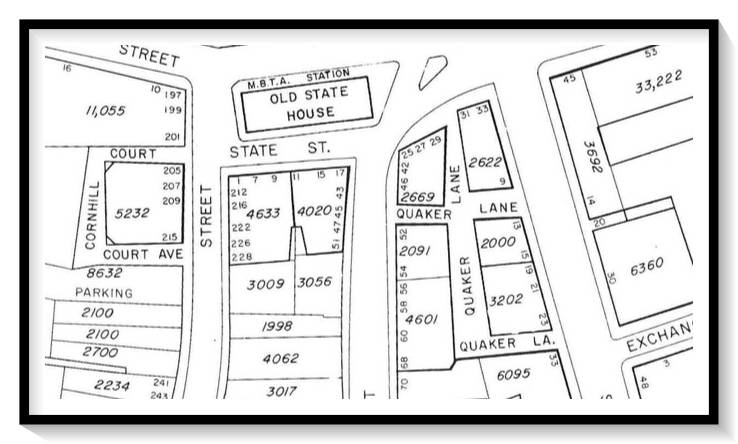
Map of the Area around Quaker Lane.
King Chapel Memorial
Chevalier De Saint Sauveur monument at King Chapel
Next to the King Chapel is the King Chapel graveyard where some of Boston's most famous are buried.
Between King's Chapel and the graveyard is a special monument that many tourists may not notice - The Chevalier De Saint Sauveur monument.
This is a special monument in honor of Chevalier St. Sauveur, a French officer that was killed in Boston during a riot during the early days of the American Revolution.
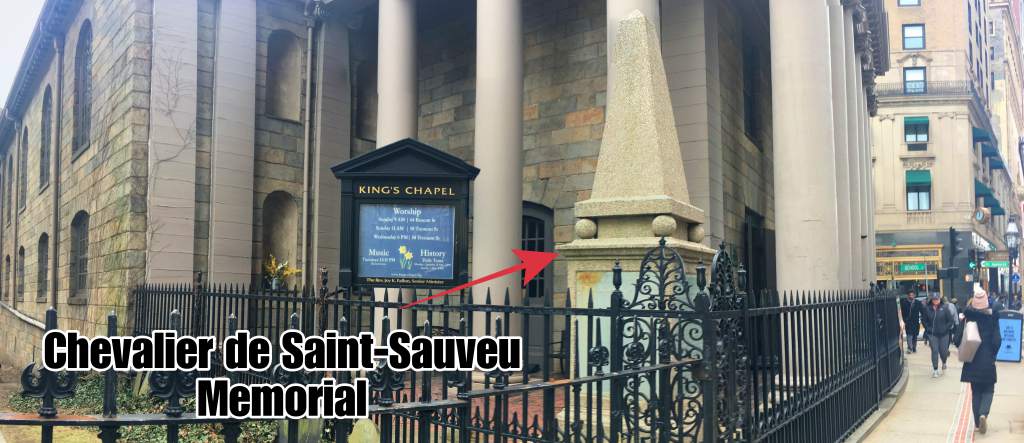
Some of the Things I learned about the Chevalier De Saint Sauveur Monument
- After a treaty of alliance was signed between France and the United States on February 6, 1778, France sent a fleet of twelve ships and 5 frigates under the command of Count d'Estaing to aid the Americans in their fight against the British.
- Chaevalier De Saint was a lieutenant on the boat named "Tonnant." His brother-in-law was Count de Breugnon one of Count d'Estaing "Chefs d'escadre." Chevalier was the first chamberlain of Count d'Artois, the brother of Louis XVI.
- The fleet arrived in various cities, including New York and Philadelphia. On the way to Rhode Island, several vessels were damaged in a huge storm. They went to Boston to get the boats fixed.
- On September 9, 1778, there was an attack by rioters at the fleet bakery, which was near the boats, Chevalier De Saint Sauveur was wounded by a blow to the eye in the face while trying to maintain order.
- He died a week later on September 15. The next day, the Massachusetts Bay general council voted to put a memorial - They feared that the French would send back all their troops home because they were not welcome.
- The French government refused any formal burial and accepted the offer to build a monument. They accepted that the death was not a threat to the remaining troops there.
- D'Estaing drafted the inscription for the monument -- dated September 28th in the log book of the "Languedoc" -- and caused copies of it to be distributed in the fleet that every one of the words to be put on the monument.
- He was buried in the basement of Kings Chapel in a private ceremony attended by his fellow officers.
- Col. Thomas Dawes, a cousin of William Dawes, was in charge with the duty of erecting a monument.
- The monument was completely forgotten until a researcher in 1912 discovered the Massachusetts Bay offer in a journal.
- A monument was finally approved in June 1, 1916 for $1,000 monument in Chevalier De Saint Sauveur at the Kings Chapel.
- The Text on the monument was written by Charles Henri Hector d'Estaing, French General, and Admiral. The next on the memorial is the same text the was written on September 28, 1778, by D'Estaing. (The top part was translated into English so the locals can read it.
- Mr. A. W. Longfellow was the Memorial architect and was inspired other monuments that were popular when Chevalier De Saint Sauveur was alive.
- The monument is made of concrete granite, fourteen feet high, and was made by Emerson & Norris of Boston
- There are four cannon balls and green slates on all sides, only 2 sides have text. (Originally there was to be a full transcript of D'Estaing inscription, but that didn't happen.)
- The monument is placed directly above where Chevalier De Saint Sauveur is buried in the basement of the King Chapel Church.
Memorial Text Translation
This officer, aide-major of the French squadron and Lieutenant [on the Tonnant] after having Had the happiness of risking his life for the service of United States, fulfilled its duty when it was the Victim of a tumult caused by malicious people: Death [15 September 1778] with the same attachment For America, the bonds of duty and inclination who are attaching his compatriots to the city of Boston in Have been more tight. May be so fruitless For all efforts what would dare to try to separate Frances and America. This is the prayer that will In the centuries to come to Almighty God, all French and all Americans who will cast their eyes on The mausoleum of a kidnapped young man has friends who do not Can console themselves for having lost. What about Like funerary flowers spread over his tomb.
This inscription has been prepared by the COUNT OF E STAING The admiral commander of the first French squadron Envoy speaks Roy from France to the United States of America
Celebration Toast of Friendship
A few days after the burial the men in command of the new country invited the men of the French Fleet to a celebration of friendship at Faneuil Hall. On September 22nd, 1778 the following toast was made:
The Memorial to the America.
The King of France.
Congress.
The French Fleet.
Gen. Washington and the American Army.
The Independence of America.
The alliance between France and America ; may it never be broken.
The French Minister to Congress.
Franklin, the American Minister at the Court of France.
Liberty and the Friendship of France.
Commerce, Art, and Agriculture.
M. d'Orvilliers and all his Army.
The Count d'Estaing and all the Officers of the French Fleet in Boston Harbor.
d'Estaing Toasted
The President of the Council and all Americans here present.
Monseigneur, the Duke de Chartres.
The Queen of France.
M. Du Chaff ault.
The Marquis de La Fayette.
American Ships and Sailors.
All the Women and Young Girls who have lost their Husbands and Sweethearts in the Good Cause.
The Duke de Choiseul.
M. de Sartine.
M. de Maurepas.
Endicott Statue
Statue in Bostons Fenway has a bit of history
The John Endicott statue is located on Forsyth Way between the Fens gardens and the Museum of Fine Art.
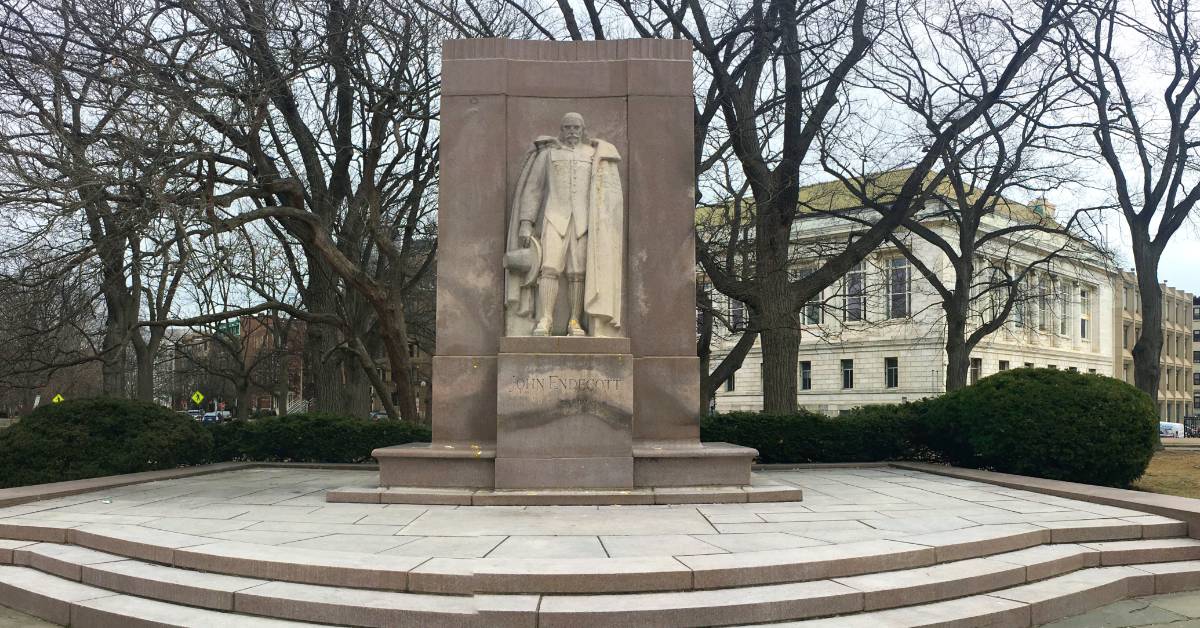
Six Interesting things about the Statue
- Unveiled on June 15, 1937
- Funded by George Augustus Peabody, a descendant of John Endicott
- John Endicott Statue is Eight-feet tall and the backside is 10 feet wide and 17 feet wide. The entire statue is made in granite.
- The original granite block weighed 12 tons, and after the statue was created it weighed 10 tons.
- Ralph Wed Gray was the Architect
- Carl Paul Jennewein was the sculptor - who's other worked include the Two Panels inside the White House and 50+ separate sculptures in the Justice Department Building
- John Endecott is regarded as one of the Fathers of New England. He was the longest serving Governor of the Massachusetts Bay Colony.
- Born on March 15, 1588, in Devon, England. He came to the New World (Salem Massachusetts) in 1628 to help bring some order to the New World
- There isn't much known about John Endicott life in England.
- John Endecott and John Winthrop, were the first two governors of Massachusetts Bay Colony. Between xx and xx they alternated governorship responsibilities.
- In 1636, John Endecott lead a group of colonial volunteers against the Pequots on Block Island - Part of Rhode Island. This military action started the Pequot War. The resulting war killed 700 Pequots - virtually extinguished the tribe.
- He gave the final orders to have Mary Dyer executed because she didn't listen to the court. The court had asked her multiple times to stay away from Boston.
- Died March 15, 1665 (Age 77) and is buried in tomb 189 in Boston's historic Granary Burying Grounds.
- For many years people thought he was buried at the nearby Kings Burying Grounds. It wasn't until xxx that the records were set.
Quotes on the Statue
Strong valiant John wilt thou march on, and take up the station first, Christ cal'd hath thee his soldier be, and faile not of thy trust. Edward Johnson 1654
Bequest of George Augustus Peabody, Esquire of Danvers, Massachusetts.
On a separate plaque:
"Ralph Weld Gray, architect/Carl Paul Jennewein, sculptor/1936."
Eight Interesting things I learned about John Endicott
Finding the Statue
The statue is located on Forsyth Way near the Museum of Fine Arts. If you take the Green Line and get off at the Northeastern University stop.
PermalinkBoston Bricks
A small Boston Alley highlights some history of Boston
Just off of Arch Street, just a few blocks from Downtown Crossing, is a shortcut alley to Otis St. Look closely on the ground as you walk by to get a glimpse of Boston History.
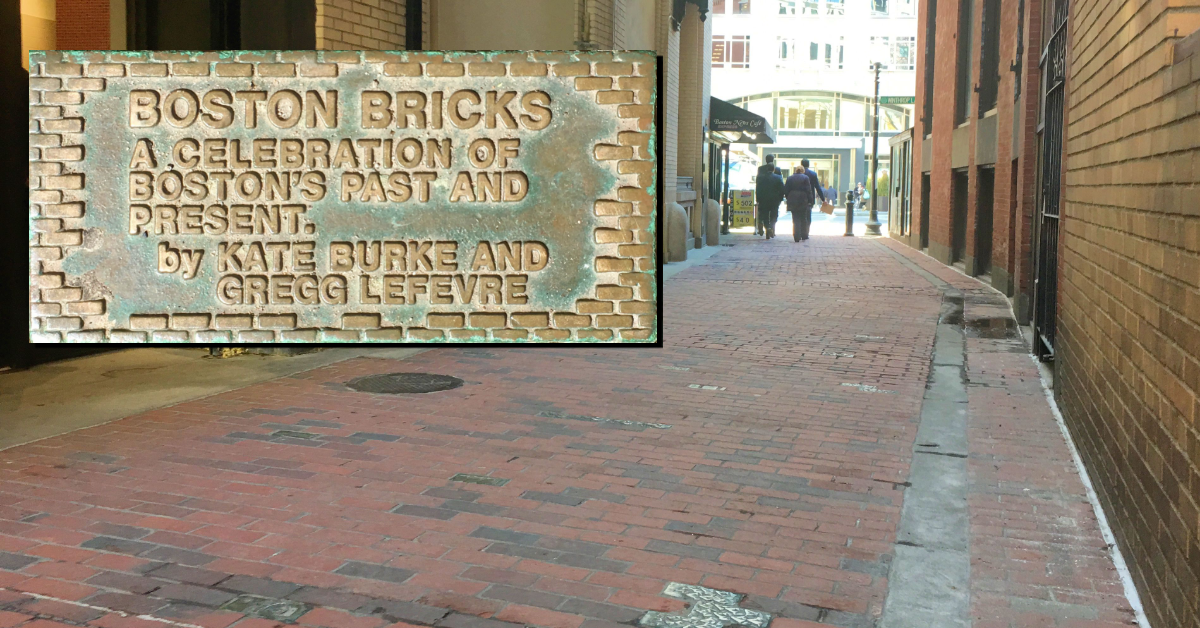
Ten Things I learned about the Boston Bricks Alley
- Officially created in 1985.
- Alley was formally was named Snow Place.
- There are 100 bronze bricks that highlight the past and present life in Boston
- Funded by the Edward Ingersoll Browne Fund - which has funded many Boston beautification projects.
- Other projected that the foundation funded includes: Law Enforcement Memorial Foundation at the State House, Goody Memorial, Soldiers And Sailors Monument in the Boston Commons and the Fountain in Franklin Square to name a few...
- Alley was designed by CBT/Childs, Bertman, Tseckares & Casendino Inc. Architects.
- There's no sign that it is "Boston Bricks Alley." The only indicator is a single brick located at both entrances. Near-by Pi Alley has lots of signs to indicate the name of the Alley. There is a large in-ground plaque thanking those that help make the 1985 restoration possible - see below.
- There hasn't been any new brick added to the alley since 1985
- Kate Burke and Gregg Lefevre were responsible for many of the designs. Both are still active in the art community.
- The Artwork was made copper so that as people walk over them it keeps them nice and shiny. They can't be raised too high off the ground otherwise people may trip over the artwork.
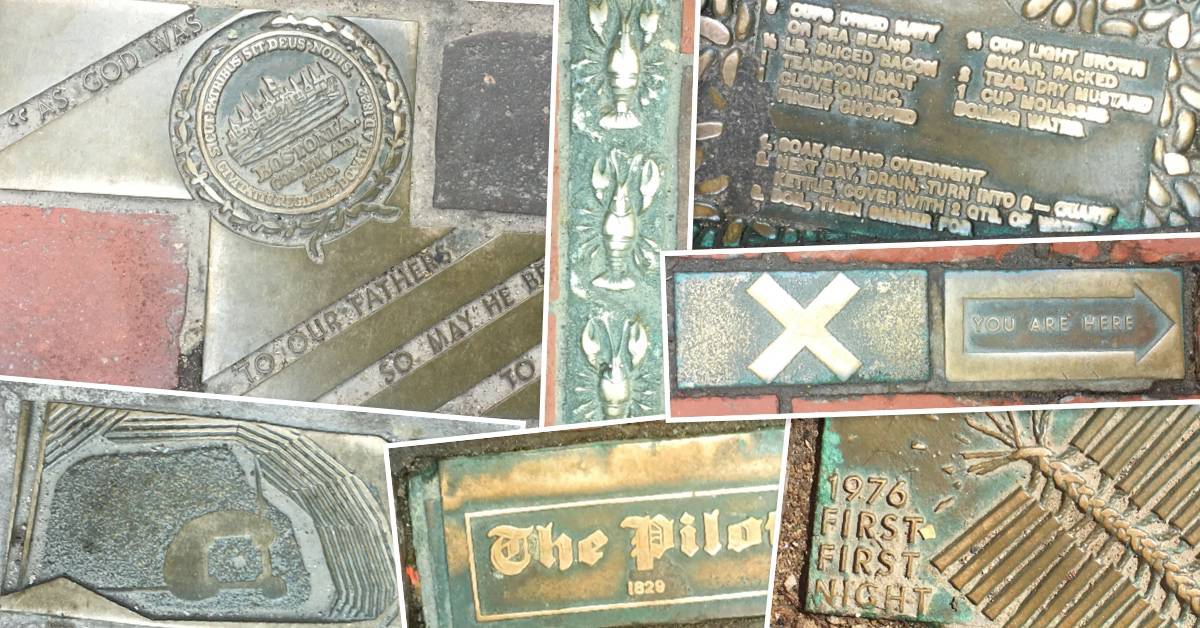
Some of the markers on the ground - including a recipe on how to make the best Boston Baked Beans. (You can learn a lot of things on the Streets of Boston.)
Ground Plaque
There is a plaque by the entrance which briefly describes the lane.
Winthrop Place, originally known as Snow Lane, was restored in 1985 through support from the Browne Fund Commission Mayor Raymond L. Flynn, Chairman City Councillor Christopher Iannella, Treasurer George A. Russell. This fund was made possible by the generous legacy of Edward Ingersoll Browne (1833 - 1901)
33 Years Later
It's been 33 years since Winthrop Lane has gotten updated. There's has been a lot going on in the City of Boston since then. Here are my thoughts on new bricks that should be added to the street:
- City of Champion - Red Sox, Bruins, Patriots, Celtics
- Mass Pike Toll Booths
- Johny Most Microphone
- Duck Boats
- Big Dig - Central Artery Project, Ted Williams Tunnel
- 9/11 Memorial
- Boston Strong
What do you think? Are there any special bricks that should be added to the street?
Finding the Boston Bricks Alley
Winthrop Lane is located next to the St. Anthony Shrine on Arch Street. The nearest T station stop would be the Downtown Crossing. The alley is located at the second crosswalk on Arch Street (When you walk from Downtown Crossing)
PermalinkSalada Tea Doors
Not so-famous doors of Stuart Street
In the Back Bay there is a unique set of decorated brown doors. These doors are a reminder of how the building once played an important part of the growth of the Commercial Industry in Boston.
The building was once the United States Headquarters for the Salada Tea Company. They not only had executive offices in the building but the building also had a warehouse where tea bags were manufactured.
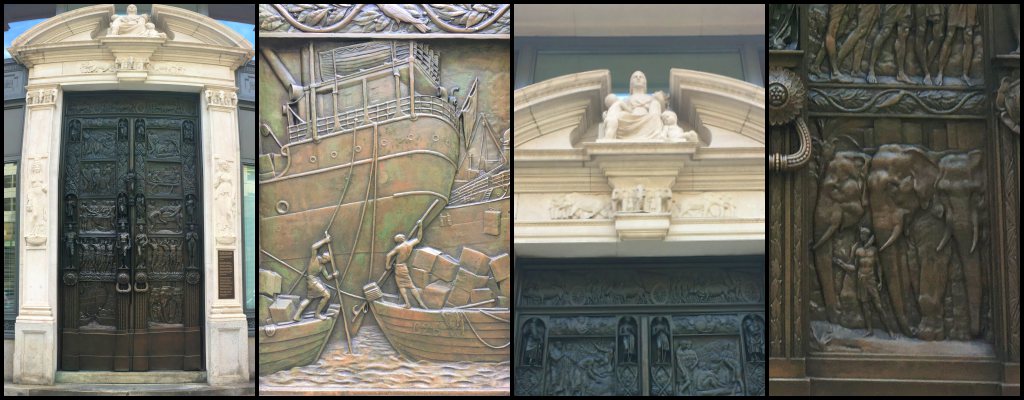
Ten Things I Learned About the Tea Doors and the Building
- Building was constructed in sections, first was done in 1917 and the second in 1927.
- The building was once known as the largest in the world devoted exclusively to the merchandising of tea.
- Peter Larkin, the founder of the Salada Tea Company, was found of the Boston office and decorated the building with beautiful works of art that some people thought that it "resembled a museum more than a business office."
- The bronze doors were installed in 1928 - where executives would enter the building.
- The bronze doors show 10 scenes from the tea trade. Each panel tells the historic story of the tea "as it was planted and exported years ago and of the culture associated with this product on the faraway island of Ceylon."
- The doors were designed by English sculptor Henry Wilson. His only other United States work was the Brozen doors at the Cathedral of Saint John the Divine, New York. Most of his architectural works were around London.
- Peter Larkin, died on February 3, 1930 in London.
- The Salada Tea Company merged into Salada-Shirriff-Horsey Inc. in June 1957.
- In 1958, the newly formed company acquired the "Junket" dessert product company in Little Falls, NY. The company headquarters was moved to New York.
- The building is currently now known as "Berkeley Place."
- The Tea doors are not registered as Boston Landmark. (Should it be?)
Tea Doors Sign
A sign next to the door reads...
English sculptor Henry Wilson was commissioned to design these doors by the Salada Tea Compay founder Peter Larkin.
Cast by The Gorham Company in 1926, the bronze panels depict the 1920's Ceylon tea industry from planting through harvest and export. Figures representing Indian deities frame the bronze panels. The bronze door was awarded the highly distinguished silver medal at the Paris Salon of 1927.
The Marble surrounding the door consists of reliefs executed by French sculptor M. Caesar Caira and show Demeter, Triptolemus, and Persephone; Greek gods associated with agriculture and harvest. Projecting elephant heads form the capitals of the pilasters and profiles of elephants form the frieze above the doors. Salada Tea Company moved its headquarters from this building and Liberty Mutual owns the building today.
Finding the Tea Doors
The Tea Doors is located at 300 Stuart Street, Boston Ma. It's located between the Berkeley Street intersection and the Stuart St Pedestrian overpath. Next to the Grill 23 & Bar.
PermalinkAbout
There are many interesting things and places around Boston, MA that you should know about. Here are a few that caught my attention. From historical sites such as the USS Constitution Museum, the Freedom Trail, and the iconic Fenway Park, to modern attractions like the New England Aquarium, the Boston Public Market, and the Isabella Stewart Gardner Museum, there is something for everyone. Whether you are looking for a fun family trip or a romantic getaway, Boston has it all.
Check out all the blog posts.
Blog Schedule
| Saturday 12 | Internet Tools |
| Sunday 13 | Misc |
| Monday 14 | Media |
| Tuesday 15 | QA |
| Wednesday 16 | Pytest |
| Thursday 17 | PlayWright |
| Friday 18 | Macintosh |
Other Posts
- Japanese Temple Bell
- State House Great Hall Clock
- Boston Logan International Airport
- Ames-Webster Mansion
- The Midtown Hotel
- Boston Courtyard Copley Square hotel
- St. Francis of Assisi Garden
- Massachusetts Law Enforcement Memorial
- Boston Skyline from Fenway Park
- Boston Public Gardens Foot Bridge
- Boston Fan Pier Park
- Harriet Tubman Park
- The Christian Science Plaza
- Memorial Day Flag Garden
- Thinking Cup